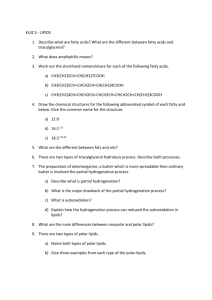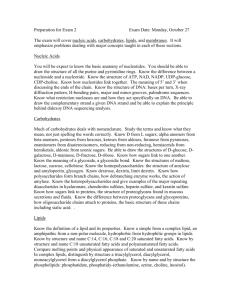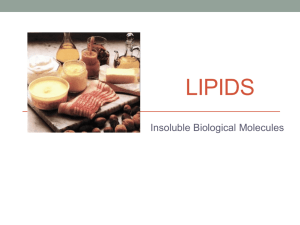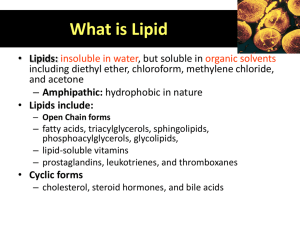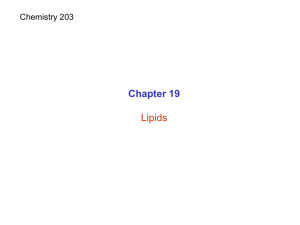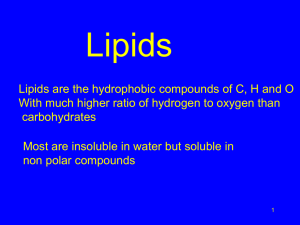Prezentation Lipids
advertisement
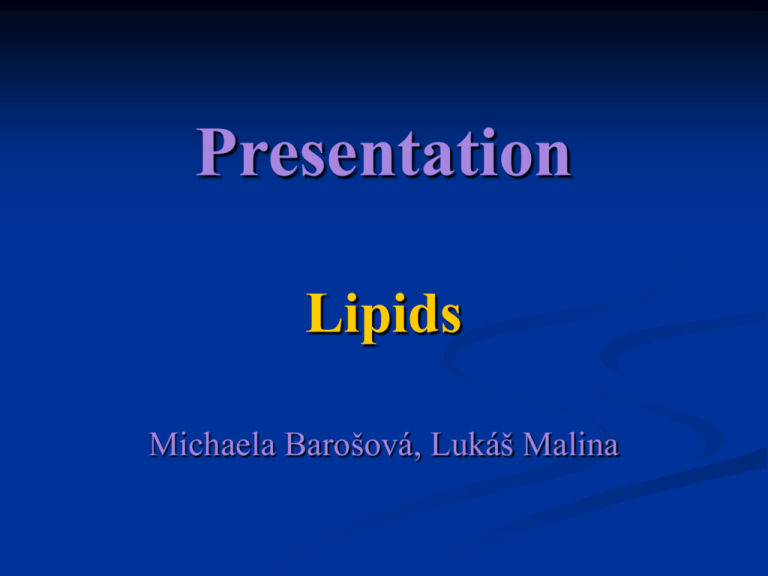
Presentation Lipids Michaela Barošová, Lukáš Malina Properties of Lipids The Lipids are esters of long chain fatty acids and alcohols (glycerol). They are a large and diverse group of naturally occuring organic compounds that are generally insoluble in water – they are hydrophobic soluble in nonpolar solvents such as ether, chloroform, aceton etc. There is a great structural variety among the lipids. diverse - různorodý occuring – vyskytující se Functions of Lipids 1. 2. 3. 4. 5. store and source of energy for animals and people solvent (for the lipid soluble vitamins such as A, D, E, K) structural components of biological membranes protective function – they protect some organs in human body (kidneys) both lipids and lipid derivatives serve as vitamins and hormones store – rezerva, zásoba source – zdroj protective - ochranný serve - sloužit Classification of Lipids 1. • • • 2. • • Homolipids Fatty acids and their derivatives Triacylglycerols Wax esters Heterolipids Phospholipids Sphingolipids wax - vosk Fatty Acids • • • their name mostly reflect their sources natural fatty acids may be saturated or unsaturated linoleic and linolenic fatty acids are essential - their absence in the human diet is connected with health problems (increased dehydration ) reflect – odrážet saturated - nasycený Saturated Unsaturated Common name lauric acid Common name palmitoleic acid myristic acid palmitic acid stearic acid oleic acid linoleic acid linolenic acid arachidic acid arachidonic acid Triacylglycerols • • • • • the triesters of fatty acids with glycerol (1,2,3trihydroxypropane) - CH2OHCHOHCH2OH are contained both in plants and animals represent one of the major food group of our diet solid at room temperature are classified as fats (occur mainly in animals) liquid are called oils (mainly in plants, but triacylglycerols from fish are also oils) Triacylglycerols - continued • • fats have a predominance of saturated fatty acids oils are composed largely of unsaturated acids herring – sleďový corn – obilí peanut – burský oříšek Animal fats butter human fat herring oil Plant oils coconut corn olive soyabean peanut Reactions of Triacylglycerols • the acid-catalyzed hydrolysis is used for production of candles: CH2–O–COR1 CH2–OH │ │ CH–O–COR2 + 3H2O CH–OH + │ │ CH2–O–COR3 CH2–OH R1–COOH R2–COOH R3–COOH Reactions of Triacylglycerols continued • the base-catalyzed hydrolysis (saponification) is used for production of soaps • potassium soaps are soft and were then converted to the harder sodium soaps by washing with salt solution CH2–O–COR1 CH2–OH │ │ CH–O–COR2 + 3NaOH CH–OH + │ │ CH2–O–COR3 CH2–OH R1–COONa R2–COONa R3–COONa Waxes • are esters of fatty acids with long chain monohydric alcohols (one hydroxyl group) • waxes are widely distributed in nature • the leaves and fruits of many plants have waxy coatings – protect them from dehydration and small predators • examples: spermaceti: CH3(CH2)14CO2-(CH2)15CH3 beeswax: CH3(CH2)24CO2-(CH2)29CH3 Phospholipids • • • structural components of biomembranes hydrophobic domain: composed largely of fatty acids hydrophilic domain: containes phosphate or other polar groups Sphingolipids • • important components of animal and plant membranes contain long – chain amino alcohol, in animals sphingosine compose – skládat se sparmaceti - vorvaňovina beeswax – včelí vosk References • • • • http://education.yahoo.com/reference/encyclopedia/entry/lipid http://encyclopedia.wikipedia.org/wiki/lipid http://biology.clc.uc.edu/couses/bio104/lipids.htm http://www.cem.msu.edu/reusch/VirtualText/lipids.htm Thank you for your attention



